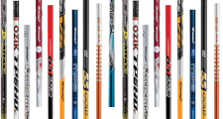As senior golfers know all too well, the aging process can have a frustratingly detrimental impact on our golf swings. The gradual loss of muscle mass that we all experience as we get older, along with a decrease in overall flexibility, combine to rob us of the longer, looser, and faster swings that we once had. The unfortunate result: slower swing speeds that produce less distance.
The senior golf players that will benefit the most from custom shafts are those with medium to high swing speeds, an aggressive transition from backswing to downswing, and the ability to “feel” the bending of the shaft during the swing. Otherwise, probably it’s not worth the investment.

Senior Golfers seek to compensate for the loss of distance due to aging
Is there a way to forestall these effects as we age? Well, part of the answer to this problem is, of course, to try to stay as loose and flexible as possible, for as long as possible. Stretching exercises and some age-appropriate weight training can definitely stave off the hand of father time somewhat.
But there is another way to maintain some of the distance that you’re losing as you age. And that is by taking full advantage of the benefits that modern golf equipment technology has to offer.
There are several design enhancements that are engineered into today’s equipment, almost all of which will make the game easier for the senior golfer – things like clubheads that are more forgiving, adjustable drivers with settings that can be tweaked to provide an optimized ball flight, etc. Understanding and using these advanced features can make a big difference in your game.
But there is one component in particular that can have significant impact on the distance and accuracy that senior golfers are able to produce, and that component is the subject of our discussion here. That component is the golf shaft.
Stock Shafts Vs. Aftermarket Shafts
Basically, there are two general categories of golf shafts: the “stock” shaft and the “aftermarket” shaft. Put simply, stock shafts are those shafts that come pre-installed in a club when you purchase it online or in a golf shop. Aftermarket shafts are ones that you can buy subsequently, as a replacement or upgrade to the stock shaft that came with the club.
What’s the difference between the two types and which one should you opt for?
Quality and Customization
Generally speaking, the difference between the two categories comes down to a matter of quality and customization.
Stock shafts, on the one hand, can almost be thought of as the “off the rack” option. Consider that the potential buyers of a particular golf club model will have many different and unique swing profiles. Some buyers will have fast swing speeds of over 100 mph, while others will have slower swings of under 90 mph. Some will load the shaft aggressively from the top of the swing, while others will have smoother tempos that build speed gradually through the downswing. These stock shafts must accommodate all of these different types of swings, and must be cost-effective enough to keep the overall cost of the club within a reasonable price point for the buyer.
Therefore, when designing these stock shafts for the marketplace, the manufacturer must incorporate features that will appeal to, and be useful for, the broadest possible range of swing types. In a sense, you can think of stock shafts as being designed with a “one size fits all” philosophy, which obviously doesn’t allow for a lot of customization.

Aftermarket models, on the other hand, reflect the high-end of a shaft manufacturer’s lineup of products and are designed using their best technology and most exacting standards. In addition, they are usually constructed using higher-end, premium materials. One thing to keep in mind, however, is that along with the premium materials comes a premium price. There is a wide range of price points when it comes to these aftermarket shafts but, even on the low end, they will usually cost around $100, and on the high end, prices can be upwards of $300, and occasionally even much more than that.
The primary selling feature of an aftermarket shaft is that golfers with varying swing profiles can custom-order a model that is specifically suited to their individual swing characteristics. As an example: one golfer may need to generate a higher launch on his drives, while another may be seeking a lower, more penetrating ball flight. By custom-ordering an aftermarket shaft that is designed with the appropriate kick-point, they would each be able to more consistently produce their desired ball flight.
Why Would Someone Upgrade to an Aftermarket Shaft?
The decision to upgrade from the stock shaft that came with your club to an aftermarket shaft is usually made after a professional fitting session, during which your specific and unique swing characteristics are analyzed, and recommendations are made by the fitter as to what type of shaft would be most likely to maximize your performance.
To do this, most club fitters nowadays make use of sophisticated technology called a Launch Monitor to assess a player’s swing profile. A launch monitor is a high-tech, electronic device that measures all of the critical elements of your swing, as well as all of the various aspects of the ball’s actual flight. Using either Doppler Radar or state-of-the-art camera technology, the launch monitor will capture a wide range of details about each swing: the swing speed of your club, the path and angle of attack at which your club head approached the ball prior to impact, where on the club face the ball made contact, the speed of the ball after it was struck, the amount of both backspin and sidespin that the ball exhibited during its flight, the height and overall distance that the ball flew, etc.

Then, using all of these data points, a trained fitter can make determinations about whether or not you are a right candidate for an aftermarket shaft and, if so, he can make a recommendation as to which aftermarket shaft you should consider.
Is an Aftermarket Shaft Worth the Investment?
There’s been a lot of research and testing done to assess the difference in quality and performance between stock shafts and upgraded aftermarket shafts. And the findings have revealed that, in fact, aftermarket shafts do perform somewhat better than their stock shaft counterparts. In some areas, the differences are significant. In others, they are marginal. But on the whole, it’s been reasonably conclusively shown, when multiple performance statistics are compared, that aftermarket shafts do have a performance advantage.
So the question then becomes: is the additional cost of an aftermarket shaft worth it based on the amount of performance improvement that you can expect to derive?
Well, as unsatisfying as this answer may seem, the answer is….it depends. For many, it will be an unqualified “yes.” For others, though, the answer may be a “no.”
Who Are the Best Candidates for an Aftermarket Shaft?
The types of golfers that can derive the most significant benefit by going to an upgraded shaft are players that fit the following general profile:
- Golfers that have medium to high swing speeds.
- Golfers that make an aggressive transition from backswing to downswing.
- Golfers who have the ability to “feel” the bending of the shaft during the swing.
These golfers are the ones that can take better advantage of the features that are designed into these types of shafts, and also happen to be the ones who will frequently justify their premium cost.
Which Golfers Should Avoid Upgrading to an Aftermarket Shaft?
The plain truth is that, unfortunately, many golfers will be unable to see a much-added performance by using an aftermarket shaft. For someone who has a very slow swing speed, for instance, the limited improvement they will see (if any), will make it very difficult to justify spending hundreds of dollars on a premium shaft. For players that fit the following profile, they would be better advised to stick with the stock shaft that came with the club:
- Golfers that have very slow swing speeds.
- Golfers that do NOT make an aggressive transition from backswing to downswing.
- Golfers who don’t have the ability to “feel” the bending of the shaft during the swing.
Conclusion
While testing has shown that aftermarket shafts can offer some performance improvements in general, the fact is that not every golfer will be able to derive those benefits. If you are the type of golfer who fits the right profile (as described above), and can afford to upgrade, by all means you should consider transitioning to an aftermarket shaft.
If you don’t happen to fit that profile, it’s likely that your best strategy will be to continue using the stock shaft. Keep in mind that today’s stock shafts are a great deal better than the stock shafts that used to come in the clubs that we bought years ago. In fact, the materials used and the manufacturing processes employed in today’s stock shafts are quite good and will be a perfectly good option for a sizable percentage of the buying public.